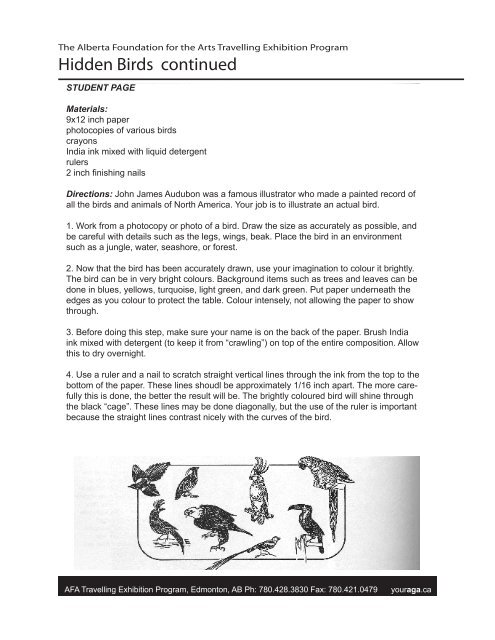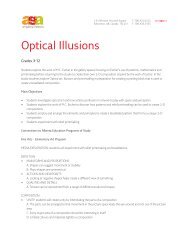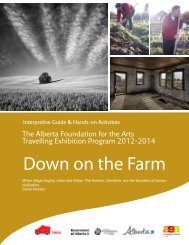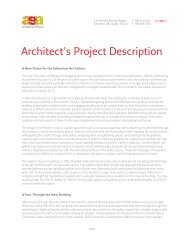A Bird in the Hand - Art Gallery of Alberta
A Bird in the Hand - Art Gallery of Alberta
A Bird in the Hand - Art Gallery of Alberta
- No tags were found...
Create successful ePaper yourself
Turn your PDF publications into a flip-book with our unique Google optimized e-Paper software.
The <strong>Alberta</strong> Foundation for <strong>the</strong> <strong>Art</strong>s Travell<strong>in</strong>g Exhibition ProgramHidden <strong>Bird</strong>s cont<strong>in</strong>uedSTUDENT PAGEMaterials:9x12 <strong>in</strong>ch paperphotocopies <strong>of</strong> various birdscrayonsIndia <strong>in</strong>k mixed with liquid detergentrulers2 <strong>in</strong>ch f<strong>in</strong>ish<strong>in</strong>g nailsDirections: John James Audubon was a famous illustrator who made a pa<strong>in</strong>ted record <strong>of</strong>all <strong>the</strong> birds and animals <strong>of</strong> North America. Your job is to illustrate an actual bird.1. Work from a photocopy or photo <strong>of</strong> a bird. Draw <strong>the</strong> size as accurately as possible, andbe careful with details such as <strong>the</strong> legs, w<strong>in</strong>gs, beak. Place <strong>the</strong> bird <strong>in</strong> an environmentsuch as a jungle, water, seashore, or forest.2. Now that <strong>the</strong> bird has been accurately drawn, use your imag<strong>in</strong>ation to colour it brightly.The bird can be <strong>in</strong> very bright colours. Background items such as trees and leaves can bedone <strong>in</strong> blues, yellows, turquoise, light green, and dark green. Put paper underneath <strong>the</strong>edges as you colour to protect <strong>the</strong> table. Colour <strong>in</strong>tensely, not allow<strong>in</strong>g <strong>the</strong> paper to showthrough.3. Before do<strong>in</strong>g this step, make sure your name is on <strong>the</strong> back <strong>of</strong> <strong>the</strong> paper. Brush India<strong>in</strong>k mixed with detergent (to keep it from “crawl<strong>in</strong>g”) on top <strong>of</strong> <strong>the</strong> entire composition. Allowthis to dry overnight.4. Use a ruler and a nail to scratch straight vertical l<strong>in</strong>es through <strong>the</strong> <strong>in</strong>k from <strong>the</strong> top to <strong>the</strong>bottom <strong>of</strong> <strong>the</strong> paper. These l<strong>in</strong>es shoudl be approximately 1/16 <strong>in</strong>ch apart. The more carefullythis is done, <strong>the</strong> better <strong>the</strong> result will be. The brightly coloured bird will sh<strong>in</strong>e through<strong>the</strong> black “cage”. These l<strong>in</strong>es may be done diagonally, but <strong>the</strong> use <strong>of</strong> <strong>the</strong> ruler is importantbecause <strong>the</strong> straight l<strong>in</strong>es contrast nicely with <strong>the</strong> curves <strong>of</strong> <strong>the</strong> bird.AFA Travell<strong>in</strong>g Exhibition Program, Edmonton, AB Ph: 780.428.3830 Fax: 780.421.0479youraga.ca
















